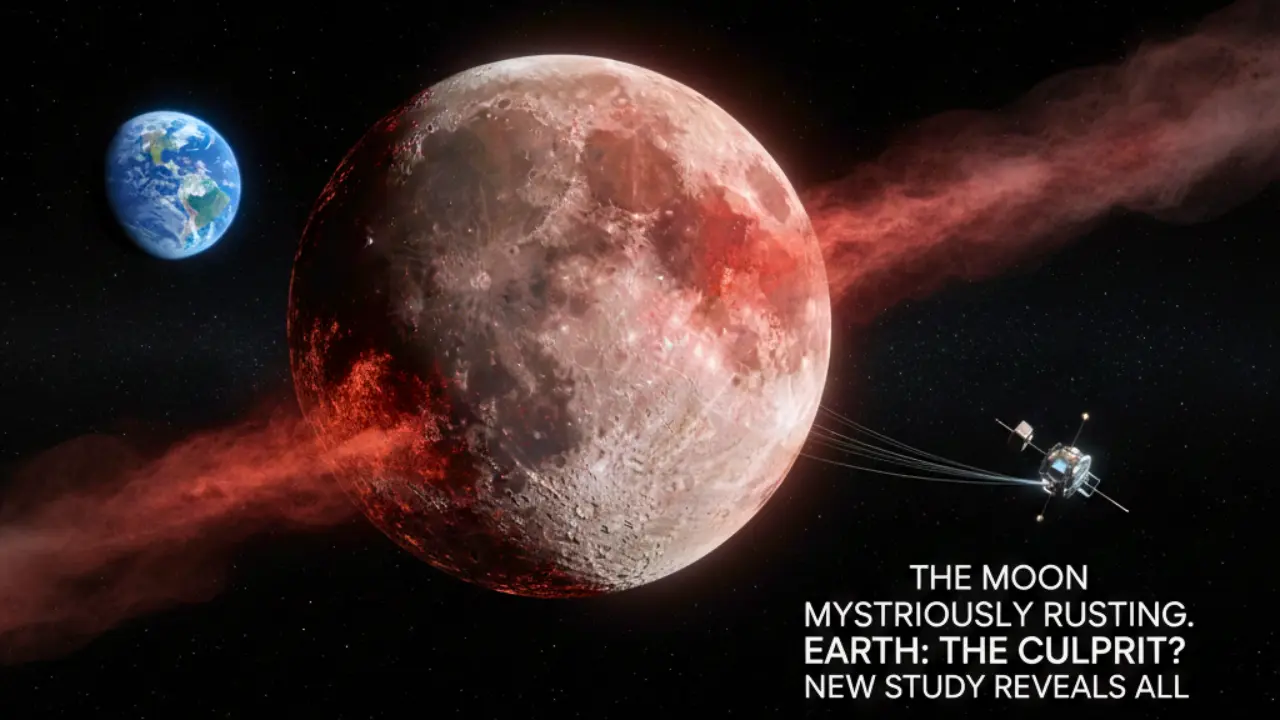For a long time, the idea of the Moon rusting seemed like science fiction. Rust, or hematite—a specific type of iron oxide—requires two key ingredients to form: oxygen and water. The Moon, a dry and airless world, lacks both in any significant quantity. So, when researchers from the University of Hawai’i and NASA’s Jet Propulsion Laboratory discovered traces of hematite on the Moon’s surface using data from India’s Chandrayaan-1 orbiter, they were completely stumped.
The discovery challenged long-held assumptions about lunar geology. Without an atmosphere to provide oxygen or a substantial source of liquid water, how could this chemical reaction possibly occur? The answer, as it turns out, is found much closer to home than anyone expected.
Earth’s “Magnetic Tail” and the Lunar Connection
The new research points to Earth as the surprising source of the Moon’s rust. Our planet is constantly bombarded by the solar wind, a stream of charged particles, primarily hydrogen, from the Sun. Earth’s powerful magnetic field, or magnetosphere, acts as a shield, deflecting these particles. However, the magnetosphere isn’t a perfect sphere; it’s stretched out into a long, trailing structure called the magnetotail, which points away from the Sun.
For about five days each month, as the Moon orbits our planet, it passes directly through this magnetotail. When this happens, Earth acts as a giant cosmic umbrella, shielding the Moon from the solar wind. This is the crucial moment. While shielded, the Moon is exposed to a different kind of “wind”—a stream of oxygen ions that have been “leaking” from Earth’s upper atmosphere and are carried along by the magnetotail.
This “Earth wind” provides the necessary oxygen for the lunar iron to oxidize. At the same time, the temporary absence of the solar wind’s hydrogen particles is equally important. Hydrogen is a “reductant,” meaning it adds electrons and prevents oxidation. By blocking the solar wind, Earth’s magnetotail reduces this anti-rusting effect, allowing the oxygen from our own atmosphere to react with the iron-rich minerals on the lunar surface.
The Role of Water, Even in a “Dry” World
While oxygen is a key part of the puzzle, water is also essential for rust to form. The Moon may seem bone dry, but we’ve known for a while that small amounts of water ice exist, especially in permanently shadowed craters at the lunar poles. A 2020 study published in Science Advances concluded that the presence of hematite is strongly correlated with the Moon’s polar regions, where water is most likely to be found.
Also Read: Witness the Power: A SpaceX Falcon 9 Rocket Launch
Scientists theorize that dust particles or meteoroid impacts could kick up these water molecules, allowing them to mix with the oxygen from Earth’s magnetotail and the iron on the surface, catalyzing the rusting process. It’s a delicate and slow-moving chemical dance that has been happening for billions of years, creating the subtle reddish hue observed on the Moon’s polar surfaces.
What This Means for Science and Exploration
The discovery that the Moon is mysteriously rusting has significant implications.
- A Chemical Link Between Worlds: It reveals a previously unknown chemical connection between Earth and the Moon. Our planet isn’t just a passive neighbor; it’s actively influencing the geology and chemistry of its satellite. This material exchange may have been happening for over 4 billion years, offering new clues about the evolution of the Earth-Moon system.
- A Record of Earth’s Past: The amount of hematite on the Moon could serve as a historical record of Earth’s atmosphere. By studying these minerals, scientists might be able to piece together what Earth’s ancient atmosphere was like and when our planet’s magnetic field first arose, providing valuable insights into our own planetary history. This is a powerful new tool in planetary science.
- Future Lunar Missions: Understanding this process is crucial for future missions. The presence of these oxidized minerals could influence the design of habitats and instruments for upcoming lunar bases.
For more information on the broader context of lunar exploration, you can explore NASA’s resources on the Artemis program.
The Science Behind the Rusting Moon
The finding is the result of years of painstaking analysis. One of the key breakthroughs came from laboratory experiments that simulated the conditions on the Moon. Researchers recreated the “Earth wind” by bombarding iron-rich minerals with high-energy ionized oxygen. The results were clear: the oxygen was capable of transforming metallic iron into hematite.
This validated the hypothesis that the Moon is rusting with Earth as the culprit. The process is slow and gradual, but it’s happening, and it’s a testament to the interconnectedness of our solar system.
Frequently Asked Questions (FAQs)
Q1: Is the whole Moon turning red like Mars?
A: No, the rusting is a very slow process and is most prominent in the polar regions. The rust is a thin layer of hematite and isn’t turning the entire Moon a visible red color.
Q2: How can there be water on the Moon?
A: Scientists have confirmed that water exists on the Moon, primarily as ice trapped in cold, permanently shadowed craters near the poles. It’s not liquid water like on Earth.
Q3: How was this discovery made?
A: The discovery of hematite was made using data from the Moon Mineralogy Mapper (M3) instrument aboard India’s Chandrayaan-1 orbiter, which was in orbit from 2008 to 2009.
Q4: Is the Moon’s rusting dangerous?
A: No, the rusting is a natural, slow-moving geological process. It poses no danger to the Moon or future lunar missions.
Q5: Will this affect future human missions to the Moon?
A: While it doesn’t pose a danger, understanding the presence of these oxidized minerals is crucial for planning future missions, especially for In-Situ Resource Utilization (ISRU), which is the process of using local materials.
A New Chapter in Planetary Science
The discovery that the Moon is mysteriously rusting has opened up a new chapter in planetary science. It forces us to rethink our understanding of how celestial bodies interact and the subtle, yet powerful, connections that exist across the vastness of space. The next time you look up at the night sky, remember that our planet, with its unique magnetic shield and atmospheric oxygen, is reaching out and leaving a tiny, but indelible, mark on our celestial neighbor.

















